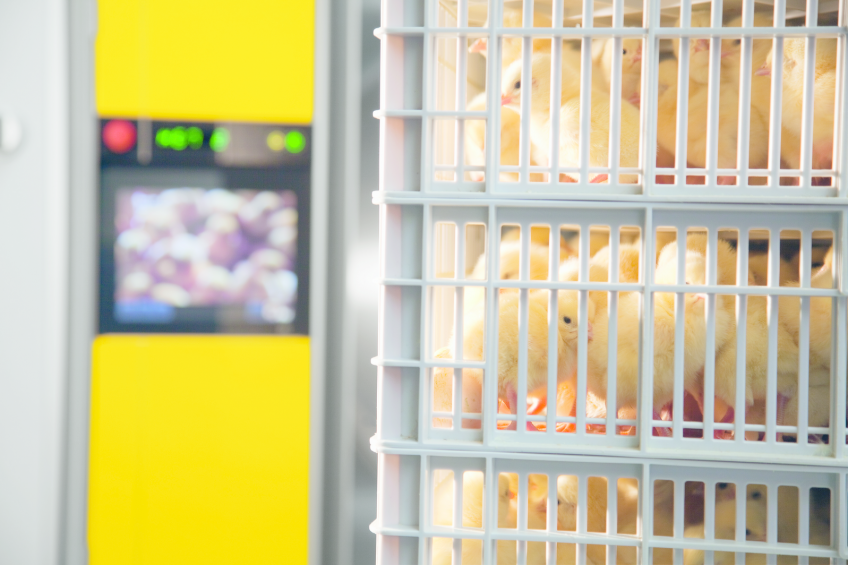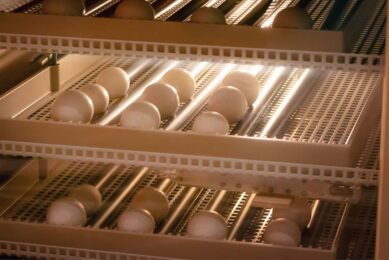Circadian incubation for broiler quality and robustness

Thermal conditioning in a commercial hatchery, is the practice that embryos receive short, daily periods of heat or cold stimuli of 1-2°C, during the second or third week of incubation. This procedure, named ‘Circadian Incubation’ improves hatchability and feed conversion rates.
By Dr Marleen Boerjan, Pas Reform Hatchery Technologies, the Netherlands, Lenise Inácio de Souza, Pas Reform do Brasil and Fernanda Flores, Universidade Estadual de Campinas, SP, Brasil
Modern poultry integrations require broilers that grow uniformly and efficiently. Efficient birds use only small amounts of nutrients to maintain their basic physiological systems and are robust and resistant to stressful conditions in the farm. Batches of robust chicks need less medication and have the potential for optimum growth.
Recently Pas Reform has introduced ‘Circadian Incubation’ as a natural and progressive development of single stage incubation. Circadian incubation is based on observations that embryonic ‘training’, or the imprinting of body functions, stimulates robustness on the farm. This ‘imprinting’ is achieved by exposing the embryo to environmental triggers, like short periods of high or low temperatures, during critical periods in embryonic development.
Mounting evidence, accumulated from scientific experiments and trials in the field, shows that short periods of thermal conditioning reduce the basic metabolism of embryos and broilers during the growing phase in the farm. Although we see clear interference with breeder management or ‘egg quality’, we conclude that there are many reasons to implement circadian incubation in hatchery practice, that improves performance throughout the poultry production chain overall.
General embryonic aspects
The female gamete, oocyte, floats on top of the yolk and is fertilised within 15-18 minutes of its arrival in the upper part of the oviduct. The single-cell embryo cleaves several times to form a cluster of undifferentiated embryonic cells. As the embryo grows, the number of cells increases and when the egg arrives in the shell gland, the first important steps of development are initiated. During shell formation, both the head-to-tail axis and the dorsal-ventral axis of the future chick are determined and differentiated. When a cell is differentiated, it is assigned a specific fate: some cells will grow to muscle tissue, while others become part of the skeleton, for example. The differentiation of cells is the result of differential gene expression, whereby muscle cells express genes for contractive proteins, while bone cells produce proteins that can bind calcium. In conclusion differential gene expression is the fundament of embryonic development. It is now generally accepted that minute variations in the environment of cells induce variations in gene expression, also called epigenetic adaptation. In our domesticated poultry breeds, we must discriminate between the maternal factors and the incubation dependent factors which imprint the developing embryo.
Different phenotypes
Embryos derived from the same parents have basically inherited similar genetic potential, yet develop to different phenotypes because the embryos were exposed to different environmental inducing or imprinting factors. Epigenetic adaptation studies how changes in gene expression patterns mediated by the environment can cause phenotype variations. An example of epigenetic adaption in poultry production is thermal conditioning (circadian incubation) during sensitive phases of embryonic development.
Maternal programming
Much more information is now available regarding maternal influence on chick quality and performance. The freshly laid egg contains not only the nutrients needed for optimum development, but egg content also reflects maternal stress, which is transferred to chicks (Rettenbacher, 2013). Experiments in quail showed that chicks produced from mothers exposed to heat stress perform better under heat stress conditions compared to standard normal conditions (Groothuis et al. 2013). We do not know whether broiler breeders, comparable to quail mothers, transfer environmental experiences to the chicks. But if so, it could explain the heterogeneity of results in experiments using hatching eggs from flocks managed differently.
When the premature egg arrives in the shell gland (uterus), the egg rotates along its long axis to form a smooth egg shell. However, as a consequence of the rotation a differential gene expression is activated in the embryo that becomes visible in the formation of the head-to-tail axis (Gilbert, 2006). The activation of differential gene expression is the result of an environmental factor: gravity as a result of egg rotation.
In conclusion, the condition of the mother hen influences the first stages of embryonic differentiation during eggshell formation, while her physical and nutritional condition is reflected in the composition of the egg and in the performance of the chick.
Influence of incubation
Today, the basic assumption in the single stage incubation programme is based on the idea that the embryo should develop under constant conditions without any fluctuation in either climate parameter. However from scientific research, it becomes clear that the so-called thermal conditioning of the embryo during specific phases of incubation induces long-term adaptations, such that post-hatch thermoregulation and performance is positively influenced (Piestun et al.,2008; Shinder et al., 2009; Tzschentke and Halle, 2009). In layers, temperature manipulation during late embryogenesis has been shown to influence postnatal temperature preference until day 8 of age (Walstra et al., 2010).
With thermal-conditioning, the embryo receives hot or cold stimulation at specific time-points during embryonic development. Thermal conditioning is only beneficial when is it applied in a clear, controlled manner for specific critical time points and duration (Tzschentke, 2008). In turkey embryos, the number of muscle cells is increased by thermal conditioning during the early phases of muscle cell differentiation (Maltby et al, 2004). In broilers, the metabolic rate of embryos and chicks is lowered after the application of thermal conditioning (12 h/day at 39.5°C/day) for embryos 14-18 days of age, when the hypothalamus-hypophyse-thyroid axis is developing (Piestun et al., 2009, 2013).
Thermal conditioning during the final phases of embryonic chick development induces a shift of the neurons in the brain involved in thermoregulation and metabolism (Tzschentke, 2007).
Thermal conditioning
In recent years, a growing body of research has shown that the thermal conditioning of bird embryos improves hatchability and feed conversion rates. Thermal conditioning in the practice of a commercial hatchery is defined as Circadian Incubation. This means that the embryos receive short, daily periods of heat or cold stimuli of 1 to 2°C during the second or third week of incubation. Circadian incubation provides the hatchery manager with an extra tool to produce high numbers of robust day-old chicks, which can cope with different environmental conditions and fully benefit from their genetic potential. Circadian incubation has been applied on a commercial scale in several broiler hatcheries in Europe and Brazil. In all these commercial hatcheries, the setters and hatchers were equipped with accurate climate controllers and sufficient cooling capacity. Short-term thermo-conditioning has been shown to improve hatching results in the majority of incubation trials, increasing final body weight by 1-2% and delivering 1 to 2 points better feed conversion rates. Results were predictable and good in most cases, with the recommendation that hatchery managers fine-tune incubation programmes carefully to achieve optimum timing and duration of temperature stimulation during thermal conditioning. In addition, results can be influenced by breeder flock management. As discussed above, this may be related to the transfer of environmental experience from the breeder hen to her chicks.
References are available from the authors upon request
Join 31,000+ subscribers
Subscribe to our newsletter to stay updated about all the need-to-know content in the poultry sector, three times a week. Beheer
Beheer








 WP Admin
WP Admin  Bewerk bericht
Bewerk bericht